BC Magazine presents a collection of writers offering their opinion on the best film of the year. While there were over 300 eligible entries, they have wilted the list down to ten. Will one of your favorites be listed? If not, feel free to mention it below. And now, our feature presentation.
Caballero Oscuro
Children of Men
Although Children of Men is centered around the tired idea of a dreary dystopian future, director Alfonso Cuaron has taken an entirely refreshing and amazing approach that will reaffirm your belief in the art of filmmaking. Adapted from a novel of the same name by P.D. James, the film presents the chilling concept of a near-future world where the entire population is infertile. No children have been born in over 18 years, and the adults have lost hope for themselves and their communities. The population stumbles through their daily routines in a rapidly disintegrating infrastructure littered with slums, abandoned schools, and fading dreams.
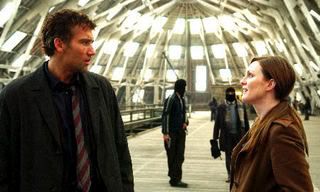 High concepts have a high probability of misfire, but Cuaron has perfected his vision of the future by focusing entirely on the reality rather than the fantasy. In turn, he has delivered a captivating, thrilling tale that transcends its source material and approaches instant classic status.
High concepts have a high probability of misfire, but Cuaron has perfected his vision of the future by focusing entirely on the reality rather than the fantasy. In turn, he has delivered a captivating, thrilling tale that transcends its source material and approaches instant classic status.
One of Cuaron’s key accomplishments is the bravura camerawork throughout the film. He could have settled for standard camera setups with multi-angle coverage and cuts, but instead designed some fascinating one-take scenes that will be studied in film schools for decades to come. One scene finds the protagonists traveling by car until they encounter an angry mob and quickly retreat in reverse gear, which doesn’t sound all that special except that the camera appears to be in the car, constantly moving from passenger to passenger to capture their dialogue at the right times as well as all of the action outside of the car. Every seat in the car was occupied, leaving even less room for maneuverability and more room for amazement. It’s reminiscent of a similar scene in War of the Worlds, but seemingly more real and thus more impressive.
Lenny Campello
Apocalypto
 Mel Gibson's Apocalypto is an action film set in the final days of the Mayan Empire. The Mayans, like many other Native American nations, have received (and rightly so) a lot of good press for their spectacular cultural achievements, sculpture, art, building accomplishments, and other good, positive things. But little has been said publicly about the darker side of the Mayas, or the Aztecs, or the Incas, etc. Enter this brutal film by Mel Gibson to change that!
Mel Gibson's Apocalypto is an action film set in the final days of the Mayan Empire. The Mayans, like many other Native American nations, have received (and rightly so) a lot of good press for their spectacular cultural achievements, sculpture, art, building accomplishments, and other good, positive things. But little has been said publicly about the darker side of the Mayas, or the Aztecs, or the Incas, etc. Enter this brutal film by Mel Gibson to change that!
Just as he did with Braveheart, Gibson picks a moment in history to tell a story of a man's love for his woman and family and set it in an action-packed environment, full of speed, gore, and spectacular backgrounds.
Kudos must be given to Gibson for creating what may be the world's first mainstream movie filmed in Mayan language (Gibson used contemporary Maya people for many of the parts in the movie).
This movie has been savaged by the critics, but it is clear to me that most of that writing has really been aimed at Gibson, rather than the film. Yes, there's a lot of violence, but there was also a lot of violence in multi-Oscar winner Braveheart, and yes, it does depict the Mayans as bloodthirsty, human sacrificers – but they were! And it does show the spectacular building accomplishment of the Mayans.
And so, in my opinion, a lot of the negative criticism of this film, in violence-happy Hollywood, is unwarranted for the film and more a heavy-handed response to Gibson's spectacular success with The Passion of the Christ, coupled with his despicable behavior when arrested in Los Angeles.
If you don't like violent action in films, then avoid this movie. If you want to be entertained by Gibsonian trademarks of magnificent settings, grand scenery, a tight, action-packed plot, a simple story of a young man going Rambo on his tormentors and what should be award-winning sets and costumes (although the film has already received a Golden Globe nomination for Best Foreign Language Film), then go and enjoy a typical Gibson film.
Alan Dale
Fateless
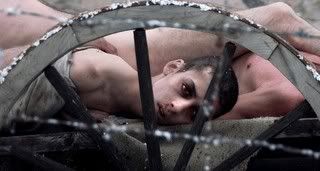 I'm living a joke out of Annie Hall — my boyfriend has said he won't watch any more Nazi or Holocaust movies. And just when they've reached an all-time peak! Oliver Hirschbiegel's monumental anti-epic Downfall was topped this year by Lajos Koltai's Fateless.
I'm living a joke out of Annie Hall — my boyfriend has said he won't watch any more Nazi or Holocaust movies. And just when they've reached an all-time peak! Oliver Hirschbiegel's monumental anti-epic Downfall was topped this year by Lajos Koltai's Fateless.
Koltai, longtime cinematographer for István Szabó, turns a visionary eye on 2002 Nobel Laureate Imre Kertész's adaptation of his 1975 work of fiction, which he based on his incarceration in Auschwitz and Buchenwald in 1944 and 1945. Most Holocaust movies, including Steven Spielberg's Schindler's List, can't forgo the traditional narrative moviemaker's reliance on character to draw the audience into the story. This is a bad fit for the Holocaust, because the Nazis' methods completely detached fate from character. In that respect, history and our narrative traditions parted ways, and Koltai is the first moviemaker to capture this aesthetic difficulty and historic reality.
At the beginning of Fateless, when Gyuri Köves (Marcell Nagy), a slightly spoiled, upper-middle-class Budapest teenager, is sent to his first extermination camp, you may fear it will be a juvenile romance in which the hero learns important lessons (i.e., Andy Hardy in Auschwitz).
As Gyuri is starved beyond a point at which he recognizes himself or harbors any hope except to survive from moment to moment, however, the movie daringly drifts into near incoherence, while getting more and more unsettlingly beautiful. Fateless thus conveys the experience of extreme depersonalization in the camps without a bit of sentimentality, while its imagery becomes rapturous, without the aesthetic seductiveness you associate with the movies. It's a masterpiece.
Duke De Mondo
United 93
 Couple nights past, being well knackered and near shagged asunder with the relentless razzamatazz of the Season, I found myself crawling four feet ‘neath the duvet for to sleep the sleep of the stricken Goliath and dream myself a fanciful scene not a fart’s breadth removed from the following:
Couple nights past, being well knackered and near shagged asunder with the relentless razzamatazz of the Season, I found myself crawling four feet ‘neath the duvet for to sleep the sleep of the stricken Goliath and dream myself a fanciful scene not a fart’s breadth removed from the following:
I was perched by a water-pump in the company of a right queer old fella sat picking various articles of varying size from out the confines of a gargantuan welly-boot. Upon retrieving each item, he’d study it a moment with a savage squint in the peepers, afore sighing a curse and flinging it over his shoulder. Some ten or twelve minutes I watched this, afore I found the courage to ask, “Tell me this, now; what, by Luther’s teeth, are you fidgeting about in that there boot for?”
“What I’m looking for,” says he, by way of an answer, “Is the best film of the year 2006. Many’s a fine daughter I’ve plucked from herein, but, now, I’d be hard pressed to say any of them would be befitting such accolade.”
Thus he grunted and muttered and inspected and poked, flinging aside a Pan’s Labyrinth here (“Beautiful and remarkable, but not the one I’m after”), a Borat there (“I laughed so hard I shit the pants o’ the parish priest by accident, but no”), the odd Brokeback Mountain or Proposition or Talladega Nights or Jackass 2 or Tzameti. But with no joy to be had.
A fortnight passed, and all the while he rummaged about in that boot ‘till the fingers of his right hand were worn to well past the shoulder-blade. A fortnight, says I, and me sat there all the while in mighty anticipation, before he let loose a great roar of “Yes!” startling me something shocking. “I found it! I found the evasive bugger after all!”
And indeed he had.
As if to prove it, he there and then produced for me the work in question, and I’ll be damned if it wasn’t scorched knee-deep with the words Best Flick Of 2006. What it was, it transpired, was Paul Greengrass’ United 93.
I nodded. I said, “Aye, it was surely the best of the year by anyone’s reckoning. Brave and horrifying and strangely uplifting and not at all anything a man can forget in a hurry. But not the best film for to take the lady-friend and her sister to see of a summer’s night, by way of providing the funnest o’ times for all involved. This I discovered one evening in sunny July.”
“No,” says he. “It’s a right prat of a lad would do anything of the sort.”
“Mind you, in my defence, it could’ve been much worse, for The Wind That Shakes The Barley was on next door.”
At the mention of such, The Worst Film Of 2006, as it happens, we both choked for a good six minutes, and I awoke with a great thirst to see Greengrass’ masterpiece again, and also with renewed resentment regarding the two and a bit hours I spent watching that awful, disastrously stupid Loach number.
Iloz Zoc
The Descent (Best Horror Film of 2006)
 The year 2006 saw quite a few stomach-turning — for the victims as well as the audience — films that ran the gamut from gore-fest to psychological terror. A return to 1970s realism-styled gore and sadism influenced many of the mainstream films such as Hostel and Wolf's Creek, while gems like Slither tossed in quirky humor while heaping on slimy, meaty gore.
The year 2006 saw quite a few stomach-turning — for the victims as well as the audience — films that ran the gamut from gore-fest to psychological terror. A return to 1970s realism-styled gore and sadism influenced many of the mainstream films such as Hostel and Wolf's Creek, while gems like Slither tossed in quirky humor while heaping on slimy, meaty gore.
One film stands out in its unrelenting horror, and visceral terror, and although it was released in the UK in 2005, it finally made its American theater debut this year. In The Descent, director Neil Marshall tricks you at first. You don't think it's a horror film. Hell, the damn thing starts off like an Ingmar Bergman movie. It opens on a happy note, quickly takes that away from you, and stays deadly serious until the end. The score is also more elaborate than your typical horror film, and wisely stays out of the way in the most important parts. And those parts are gut-wrenching to watch.
A group of women trapped in an unknown cave fight themselves, their fears, and humanoid creatures that want to eat them alive. You will be gasping for air as the terror starts, and the light fades, and the dinner bell rings. The film is fast-paced, well-acted, and will keep you on the edge of your seat. It is a must see for any horrorhead that likes an engrossing story with his gore.
Erin McMaster
Perfume: The Story of a Murderer
 It is always a daunting task to choose the best film of the year. So I chose a film that took on a daunting task itself — to rely on the body's senses of sight and sound to show the importance of smell.
It is always a daunting task to choose the best film of the year. So I chose a film that took on a daunting task itself — to rely on the body's senses of sight and sound to show the importance of smell.
Perfume: The Story of a Murderer is the tragically beautiful story of Jean-Baptiste Grenouille's quest to capture the scent of perfect beauty. His desire takes him on a journey to discover the art of making perfume, quickly escalating until it is a deadly obsession with a glimpse at paradise. Patrick Suskind's novel is an unlikely one to translate for the big screen, but director Tom Tykwer (Run, Lola, Run) pulls it off.
The cinematography is captivating and provides a depth of emotion necessary to follow Grenouille's obsession from start to finish. The beautiful images also give the audience something pleasing to watch for what amounts to a very long movie. The score fits the movie note for note, matching every flurry of emotion and movement Grenouille makes. The powerful combination of sight and sound allows scent to drive the film through compelling your memory to call upon the smells.
Perfume: The Story of a Murderer also employs great acting to further make up for the lack of film to physically emit odor. Ben Whishaw has a cold stare that speaks volumes for Grenouille as the serial killer turned unlikely hero. His coldness takes his awkwardness and lack of outward appeal to make a serial killer the unlikely hero of this twisted fairy tale. It is the great storytelling, however, that makes us hope Grenouille completes his quest and captures the only scent that will bring us ecstasy.
Neil Miller
Little Miss Sunshine
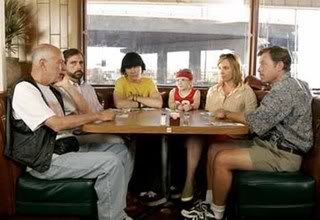 Every year Hollywood does its best to seem original, please the masses, and ultimately make some serious coin. And about this time every year, the Armani suit-wearing execs at studios like Warner Brothers, Paramount, and Fox unleash a swarm of limited release films, all playing in a few screens in New York or Los Angeles. These films are the desperate attempts of their distributors to make one last dash at Oscar glory. But this year, these attempts, while noble, will be foiled – overshadowed by a movie that was a little more charming, a little more honest, and quite a bit more original – Little Miss Sunshine.
Every year Hollywood does its best to seem original, please the masses, and ultimately make some serious coin. And about this time every year, the Armani suit-wearing execs at studios like Warner Brothers, Paramount, and Fox unleash a swarm of limited release films, all playing in a few screens in New York or Los Angeles. These films are the desperate attempts of their distributors to make one last dash at Oscar glory. But this year, these attempts, while noble, will be foiled – overshadowed by a movie that was a little more charming, a little more honest, and quite a bit more original – Little Miss Sunshine.
Playing itself off as a quaint little indie film with a solid cast, Little Miss Sunshine began the year by bringing audiences at Sundance to their knees with laughter. It showcased one of the best ensemble casts of the past decade or so, including Greg Kinnear, Paul Dano, Alan Arkin, Toni Collette, and Abigail Breslin. Each performance was unique, each character getting their laughs and shedding some tears, but it was ultimately the closeness of this family unit that made them so endearing, even through their most dysfunctional moment. Other films may have bigger budgets or some bigger names, but none of them will have what makes Little Miss Sunshine such a joy to behold – heart.
TV and Film Guy
Casino Royale
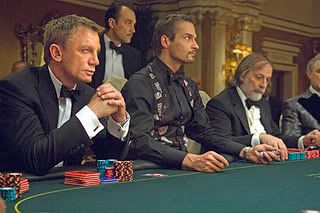 What makes a movie the "best" movie of the year? There are tons of criteria that can be used. Acting, directing, cinematography. The list is enormous. What about plot? What about the movie's importance in history? Titanic won tons of Oscars, including one for Best Picture. Looking back on it now, if the awards for that year were redistributed, would Titanic take home that many again? Probably not. So, can the "best" film of the year be determined without having the benefit of future history and distance?
What makes a movie the "best" movie of the year? There are tons of criteria that can be used. Acting, directing, cinematography. The list is enormous. What about plot? What about the movie's importance in history? Titanic won tons of Oscars, including one for Best Picture. Looking back on it now, if the awards for that year were redistributed, would Titanic take home that many again? Probably not. So, can the "best" film of the year be determined without having the benefit of future history and distance?
Shouldn't the best film of the year occupy an undeniable place in history for years to come? Shouldn't the best film of the year not only be a critical success, but a success among the movie going public as well? Shouldn't it be all around wonderful and create a new way of looking at something?
One film this year actually does all these things. One film of the year is undeniably the best that has been put forth. Looking at all these criteria, examining every aspect, the best of the year has to be Casino Royale. It represents a complete reimagining of a film icon and one of the most successful franchises in film history.
El Bicho
Drama: A Scanner Darkly
Documentary: Why We Fight
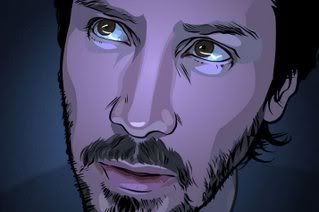 A Scanner Darkly is quite simply Linklater’s masterpiece, a brilliant puzzle of truth and identity amongst characters that are slowly losing both due to their drug addictions. It’s an insightful character study, a compelling mystery, and covers themes familiar in Philip K. Dick’s work from social problems to the reality of consciousness.
A Scanner Darkly is quite simply Linklater’s masterpiece, a brilliant puzzle of truth and identity amongst characters that are slowly losing both due to their drug addictions. It’s an insightful character study, a compelling mystery, and covers themes familiar in Philip K. Dick’s work from social problems to the reality of consciousness.
The look of the film is marvelous to behold and is made all the more captivating because the style has substance. The interpolated rotoscoping, animation created over Hi-Def video, creates an alternate reality, setting it apart from our own while at the same time creating the sensation of characters’ altered states.
Not just best film of the year so far, but possibly of the decade.
Why We Fight is a balanced, thought-provoking documentary that encourages serious debate and is not easily dismissed by its critics.
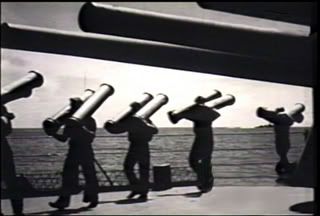 Concerned that President Eisenhower's warnings in his farewell address about the military-industrial complex have gone unheeded, director Eugene Jarecki investigates how the United States of America has become such a force in the world militarily since WWII, regardless of President or political party in charge.
Concerned that President Eisenhower's warnings in his farewell address about the military-industrial complex have gone unheeded, director Eugene Jarecki investigates how the United States of America has become such a force in the world militarily since WWII, regardless of President or political party in charge.
Some see it as the duty of America to spread democracy and freedom while others see the actions as economic colonialism where instead of taking over a country we open up new, free markets for our businesses. Both views have validity to them. There is righteousness in freeing people from oppression, yet the figurative gold rush in reconstruction efforts and other activities leaves a taint with some and keeps the work from being completely selfless.
The film also presents stories of the people directly affected by these decisions, mainly in regards to Iraq. The interviews from the people on the front lines reveals that there are many facets to the story as opposed to the usual binary banality that too often passes as political discourse.
 Blogcritics The critical lens on today's culture & entertainment
Blogcritics The critical lens on today's culture & entertainment



